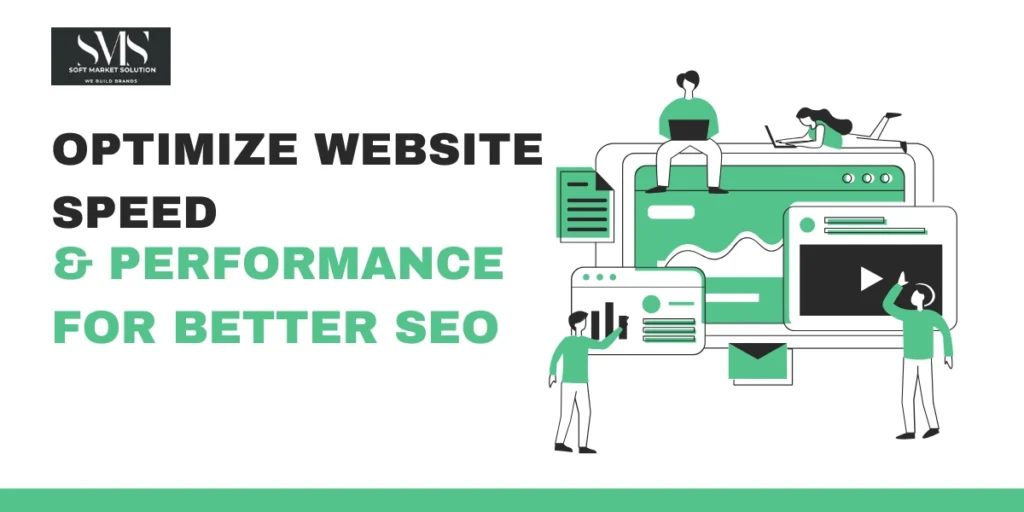
Website speed and performance are essential to SEO success, especially as Google places greater emphasis on Core Web Vitals, mobile optimization, and overall user experience.
A fast-loading website improves search engine rankings and leads to higher engagement, lower bounce rates, and stronger conversion metrics.
According to recent industry data, pages that meet all Core Web Vitals benchmarks are 24% more likely to appear in the top 10 search results. Speed is no longer optional; it’s a ranking necessity.
From reducing load times to improving time-to-first-byte (TTFB) and passing Core Web Vitals, this guide covers everything you need to optimize site performance and stay ahead in SEO.
Why does Website Speed Matter for SEO?
More than 88% of users now expect websites to load in under 3 seconds, and most will leave if that doesn’t happen.
Website performance plays a direct role in both search engine rankings and business results.
Performance metrics from 2025 confirm that
- A 1-second delay in mobile load time can reduce conversions by up to 20%
- Pages in the top 3 Google search results have an average load time of just 1.3 seconds
- Sites that meet all Core Web Vitals are 24% more likely to rank on page one
Google continues to prioritize fast, stable, and mobile-optimized websites in its algorithm. If your site lags behind in performance, it risks losing both visibility and visitors.
Understanding Core Web Vitals: Foundation of Speed Optimization
Core Web Vitals are essential page experience signals that Google uses to evaluate the real-world performance of your website.
These metrics directly influence search engine rankings by measuring how users experience your site in terms of speed, responsiveness, and stability.
The three key Core Web Vitals:
- Largest Contentful Paint (LCP), which measures how quickly the main content loads—aim for under 2.5 seconds for a fast loading speed.
- Interaction to Next Paint (INP), which assesses how responsive your site is to user inputs. A good INP score is under 200 milliseconds, ensuring a smooth and interactive experience.
- Cumulative Layout Shift (CLS), which monitors the visual stability of your page as it loads. Keep your CLS below 0.1 to prevent disruptive layout shifts.
As of 2025, Google has officially replaced First Input Delay (FID) with INP to provide a more accurate measure of user interaction quality, particularly in mobile-first and AI-enhanced environments.
Major Strategies to Optimize Website Speed & Performance
Now that we understand what Google values, let’s learn how to meet and exceed these benchmarks.
1. Compress and Optimize Images
Heavy image files remain one of the leading causes of slow-loading websites, especially on mobile devices.
To improve page load time and overall website performance, it’s essential to implement effective image optimization strategies.
Start by using next-gen image formats like WebP or AVIF, which reduce file sizes without compromising quality.
Incorporate lazy loading techniques for non-critical images and videos; this ensures that only content visible on the screen loads initially, improving perceived speed.
However, avoid lazy-loading important visuals above the fold, such as banners or hero images, as this can negatively impact Largest Contentful Paint (LCP) and user experience.
Also, make sure to serve responsive images that adapt to various screen sizes and resolutions.
According to recent benchmarks, websites utilizing next-gen image formats load up to 39% faster, making image optimization a key factor in achieving faster speeds and better SEO results.
2. Minify & Combine CSS, JavaScript, and HTML
Reducing code bloat is a vital step in improving your website’s load speed and overall performance.
By minifying CSS, JavaScript, and HTML files, you can eliminate unnecessary characters, spaces, and comments that add weight to your pages without adding value.
Additionally, combining multiple scripts or style sheets into fewer files helps reduce the number of HTTP requests required during loading, an essential factor in page speed optimization.
Tools like UglifyJS, CSSNano, and HTMLMinifier can automate this process, making it easier to implement across your site.
Note: Top-ranking websites typically make fewer than 50 HTTP requests per page, underlining the importance of keeping your code lean and efficiently bundled to enhance both SEO performance and user experience.
3. Improve Server Response Time (TTFB)
TTFB (Time to First Byte) is an important metric that measures how quickly a server responds to a user’s browser request, and any delay here can slow down the entire page loading process.
To optimize server response time, start by choosing a reliable, high-performance hosting provider that can handle your traffic efficiently.
It’s equally important to optimize backend performance, streamline database queries, and reduce reliance on third-party scripts that can delay initial server responses.
Implementing server-side caching is another effective way to deliver frequently requested content faster.
For best results, aim for a TTFB of under 200 milliseconds, which aligns with Google Lighthouse’s benchmark for fast-loading websites and contributes directly to better Core Web Vitals scores and SEO rankings.
4. Leverage a Content Delivery Network (CDN)
A Content Delivery Network (CDN) plays a key role in improving website speed and performance, especially for global audiences.
A CDN stores and serves cached versions of your site’s content across a network of edge servers, reducing latency and ensuring faster load times for users no matter where they are located.
Implementing a CDN for website optimization offers several benefits:
- Lower latency and faster data delivery
- Reduced server load by distributing traffic efficiently
- Enhanced security, including protection against DDoS attacks
In essence, popular CDN providers in 2025 include Cloudflare, Amazon CloudFront, and Fastly, each offering robust solutions for scalable and performance-focused content delivery.
5. Optimize for Mobile Performance
Mobile-first indexing dominates search engine rankings in 2025, making mobile performance optimization essential for SEO.
With more than 63% of global web traffic coming from mobile devices, search engines now evaluate your site’s mobile version as the primary version for indexing and ranking.
To ensure your site performs well in mobile search, use responsive design that adapts seamlessly to all screen sizes.
Optimize images specifically for mobile, use readable font sizes, and design with accessible tap targets for smoother navigation.
If you publish news-heavy or content-rich pages, implementing Accelerated Mobile Pages (AMP) can help improve mobile page speed and user experience.
A fast, well-optimized mobile experience supports better Core Web Vitals performance, lowers bounce rates, and contributes to higher visibility in mobile search results.
Tools to Analyze & Monitor Website Performance
Monitoring website speed and performance is an ongoing process, not a one-time fix. Regular analysis helps you catch issues early, improve user experience, and maintain strong Core Web Vitals scores.
Several powerful tools can help with technical SEO audits, page load speed diagnostics, and overall site performance monitoring:
- Google PageSpeed Insights provides detailed insights into load time, mobile performance, and Core Web Vitals.
- Google Search Console helps track performance trends across your site and alerts you to indexing or speed issues.
- Lighthouse (via Chrome DevTools) offers comprehensive technical audits to diagnose performance bottlenecks.
- GTmetrix delivers real-time website speed test results along with actionable suggestions.
- WebPageTest enables load time testing from different geographic locations for a global performance view.
Set thresholds and alerts in Search Console or Lighthouse CI to catch performance drops early and ensure your site stays compliant with Google’s speed and UX standards.
SEO Action Plan: How to Stay Fast and Visible
To maintain top rankings and deliver a fast, seamless experience in 2025, consistently apply these performance optimization steps:
- Run a Technical Audit: Use tools like PageSpeed Insights and Lighthouse to detect and fix speed or UX issues.
- Prioritize Core Web Vitals: Focus on improving LCP, INP, and CLS—especially on high-traffic pages.
- Optimize Images and Videos: Use WebP or AVIF, enable lazy loading, and ensure media is responsive.
- Minify & Combine Code: Reduce file sizes and HTTP requests by streamlining CSS, JavaScript, and HTML.
- Use a CDN: Serve content from global servers to lower latency and improve delivery speed.
- Improve Hosting and TTFB: Choose high-performance hosting and optimize backend response times.
- Ensure Mobile Friendliness: Optimize layout, tap targets, fonts, and loading speed for mobile users.
- Update Content Regularly: Keep pages fresh, relevant, and optimized to support long-term SEO success.
Why Speed will Define SEO Success Going Forward
Fast, stable, and mobile-optimized websites are key to how search engines rank content and how users engage with your brand online.
From Core Web Vitals to server response time, every second shapes your visibility, retention, and conversions.
Socio Labs, a top-rated SEO and web development company in Delhi, helps businesses build high-performing websites through clean code, mobile-first design, and scalable strategies for long-term search success.
Want to improve your site’s performance and rankings?
Connect with Soft Market Solution, a trusted web development company in India, and take the next step toward faster, smarter SEO.
